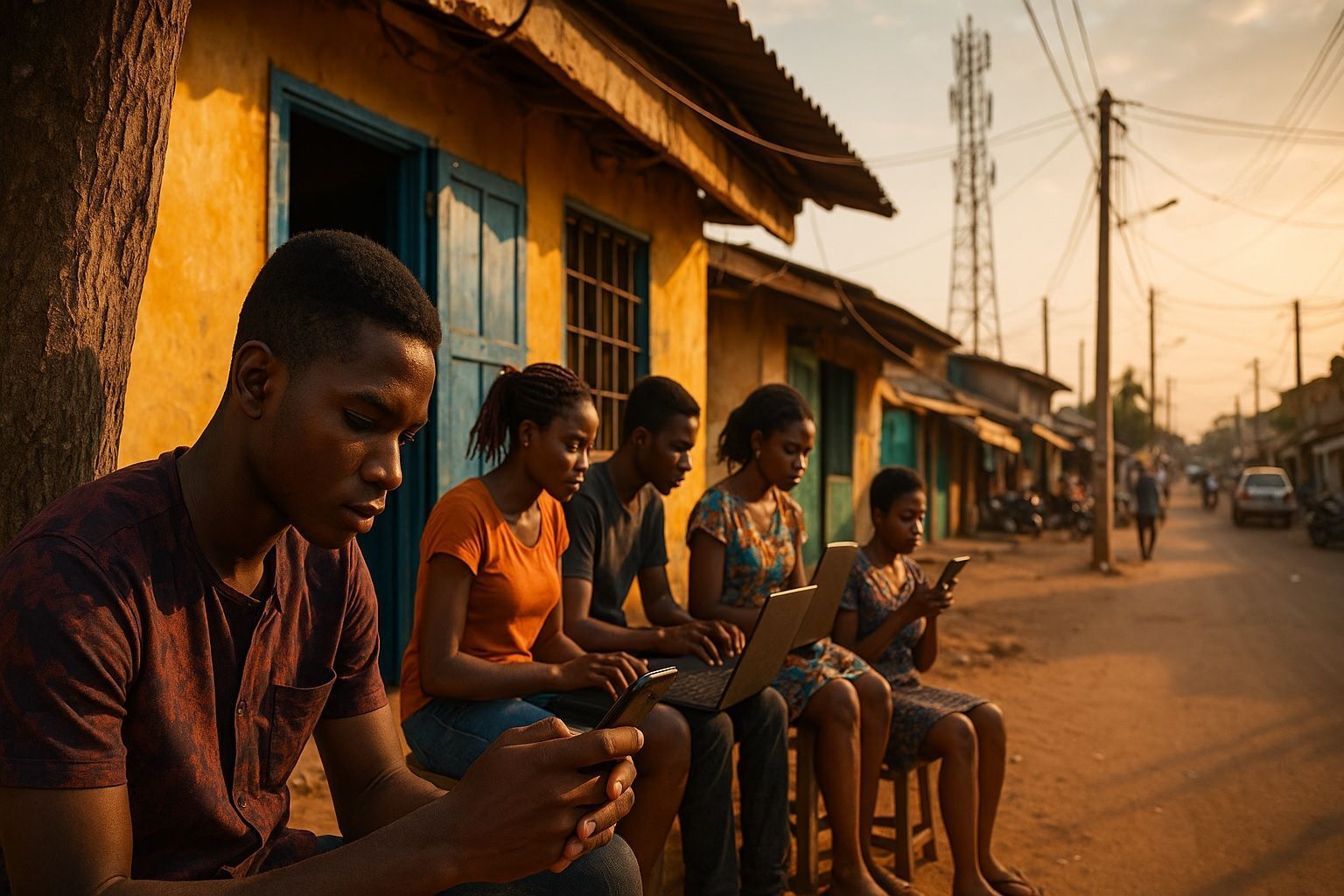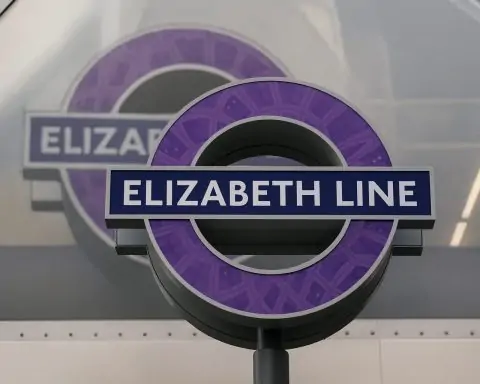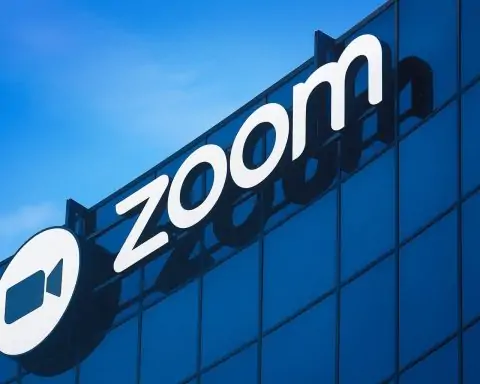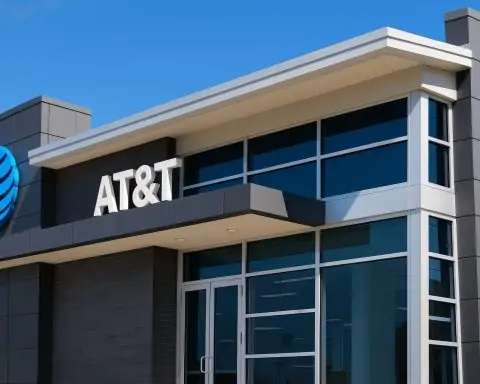- A 2,000 km national fiber optic backbone begun in 2016 was completed by mid-2021 and is being extended to all municipalities by 2025 under a CFA207 billion (~$330 million) plan to reach 3,300 km.
- Benin sits on multiple landing undersea cables such as ACE and MainOne for international bandwidth, but it still has only 1 Internet Exchange Point and 1 data center, with roughly 5% of popular web content cached domestically.
- Mobile networks dominate access, with 4G LTE coverage reaching about 90–93% of the population in 2023, 2G at 98%, 3G around 90%, and fewer than 1% of people having 5G.
- There is a sharp urban–rural digital divide: around 78% of urban residents have internet access versus 57% in rural areas, and only 17% of rural Beninese have electricity compared with 72% in urban areas.
- SBIN launched the Celtiis mobile operator in October 2022 with Senegal’s Sonatel, which had captured about 10.6% of mobile subscribers by early 2024.
- The government has a Universal Service Fund to extend coverage, and by 2019 launched an e-government portal with 250+ online services.
- Sèmè City in Cotonou was established as an innovation and tech hub to incubate startups and train youth in digital skills.
- SpaceX Starlink began service in Benin in late 2023, with a monthly subscription of CFA 30,000 (~$49) and an upfront dish cost of CFA 400,000 (~$650), and quickly attracted about 1% of Benin’s internet traffic.
- In 2024, the average price of a basic mobile internet package was about 5.67% of monthly GNI per capita, underscoring affordability challenges.
- Benin’s internet resilience rose to about 39–40% in 2023, one of the fastest growth rates in West Africa alongside Senegal.
Benin has witnessed a quiet but striking internet revolution over the past decade. In the early 2010s, internet use was in the single digits of the population; today roughly one-third of Beninese are online [1] [2]. This rapid growth has been driven by improvements in infrastructure and aggressive government initiatives, yet significant challenges remain. The following report examines the state of internet access in Benin across key dimensions – from urban connectivity and pricing to government policy and new satellite services – and compares the country’s progress with its West African neighbors. The picture that emerges is one of surprising advances amid persistent gaps: Benin is expanding fiber optics nationwide and embracing innovations like SpaceX’s Starlink, even as rural communities struggle with access and affordability.
Infrastructure and Coverage
Fiber Backbone and International Connectivity
Benin’s internet infrastructure has historically lagged, but recent upgrades are transforming its backbone. A 2,000 km national fiber optic network begun in 2016 was finally completed by mid-2021 [3]. This backbone initially linked 50 of Benin’s 77 municipalities (over 2,550 km of fiber) and is now being extended to all municipalities by 2025 [4] [5]. The government plans to reach 3,300 km of fiber covering every district, with alternative technologies (like microwave links) for the last few areas [6]. This expansion, part of a CFA207 billion (~$330 million) project under the national action plan, is meant to deliver high-speed internet countrywide and make Benin a regional digital services hub [7].
Internationally, Benin benefits from several undersea fiber-optic cables landing on the West African coast (such as ACE, MainOne and others), providing needed global bandwidth. Improved international connectivity in recent years has “contributed to a reduction in end-user pricing” and opened the door for digital transformation of the economy [8]. Benin now has diverse upstream connections to the global internet (relying on more than two submarine cables or cross-border links), which the Internet Society rates as “Good” for resilience [9]. However, the country still hosts minimal local infrastructure for data – just 1 Internet Exchange Point and 1 data center – so most content is fetched from abroad, with only ~5% of popular web content cached in-country (vs ~39% Africa average) [10]. This means that despite better backbones, Beninese users often rely on distant servers, which can affect speeds and latency.
Mobile Network Coverage
Mobile networks are the primary conduit for internet access in Benin, carrying the vast majority of connections. Cellular coverage is strong in populated areas: as of 2023, 4G LTE signals reach about 90–93% of the population [11] [12], while older 2G networks cover 98% and 3G around 90% [13]. Essentially, almost all Beninese live under at least a basic mobile network, and 9 out of 10 people have 4G available – a remarkable coverage level on par with some wealthier African countries. (5G wireless is still in pilot stages, with limited trials; <1% of people had any 5G coverage by 2023 [14].)
Despite this impressive coverage footprint, the availability of signal has outpaced actual usage. Many Beninese – especially in rural areas – remain offline even where 3G/4G exists, due to barriers like device access, cost, and digital literacy. The National Telecommunications Regulator (ARCEP) reports that by mid-2024 there were 11.06 million mobile internet subscriptions in Benin (in a population of ~13.7 million) [15], suggesting widespread SIM ownership for data. Yet the ITU estimates that only about 33–34% of individuals actually used the internet by the end of 2023 [16] [17]. This gap highlights the digital divide between those who are covered by a signal versus those who can afford and know how to use it – an issue explored more below.
Urban vs. Rural Digital Divide
Public internet access center in Cotonou, Benin (2019), a government initiative to provide connectivity to youth [18].
Benin faces a stark urban–rural gap in internet access, common across Africa but pronounced here due to infrastructure and socioeconomic disparities. Urban centers like Cotonou (the economic capital) enjoy far better connectivity – multiple mobile networks, higher 4G availability, and growing fiber deployments – while many rural villages struggle with weak signals or no local access points. Precise figures by locale are scarce, but surveys consistently show urban residents are much more likely to be internet users than rural residents. For example, one study found around 78% of urban respondents had some internet access vs. 57% of rural respondents [19] (though these percentages seem high, they illustrate the gap). Another analysis noted that across West Africa, about 47% of urban households had internet access against only ~12% in rural areas on average [20] [21]. Benin fits this pattern: cities are relatively well connected, while villages face connectivity challenges despite being nominally covered by mobile networks.
Key obstacles for rural communities include lack of electricity, poverty, and literacy. Only an estimated 17% of rural Beninese have access to electricity, compared to 72% in urban areas (national average 42%) [22]. This makes it hard to power phones, cell towers, or computer labs outside cities. Rural poverty is high (56% multidimensional poverty rate vs 24% urban) [23], limiting people’s ability to buy smartphones or data plans. Additionally, education and digital literacy are lower in remote areas. All these factors mean that simply having a 3G/4G tower nearby doesn’t guarantee meaningful internet usage. The government and partners have tried to close this gap through initiatives like community digital centers (40 opened in 2019, plus more planned) and multimedia centers in rural towns [24]. These facilities offer public internet access (as shown in the Cotonou youth center above) and training programs. Still, the rural-urban digital divide remains a major challenge: most of Benin’s online population is concentrated in coastal and urban locales, while vast rural regions are largely offline or limited to basic 2G connectivity. Bridging this divide will require not just infrastructure, but also tackling underlying issues of power supply, affordability, and skills.
Pricing and Affordability
Affordability is a critical barrier that shapes internet access in Benin. While the cost of data has come down in recent years, it remains high relative to incomes. In 2024, the average price of a basic mobile internet package (e.g. 1GB or a low-volume bundle) was estimated at 5.67% of monthly GNI per capita [25] – far above the 2% affordability target set by the UN. For context, a 2022 survey found 1GB of mobile data cost about $2.37 on average in Benin [26]. This is cheaper than a decade ago (Benin once had some of the highest data prices in West Africa), but it’s still costlier than in many neighboring countries; in fact, a 2020 analysis noted that sub-1GB data packages were 30–50% more expensive in Benin than in six of the seven other WAEMU countries (countries sharing Benin’s currency union) [27]. High taxation on telecom services has been cited as one factor driving up consumer prices [28] [29].
The impact is that lower-income people must carefully ration their internet use, if they can afford it at all. Many Beninese rely on small pay-as-you-go data packs (sometimes just a few MB) or use free basics when available. By contrast, wealthier individuals and businesses in cities might purchase unlimited home broadband or large mobile bundles – a growing but still niche market. Fixed broadband (fiber or DSL) is very costly and limited in coverage, often targeting corporate clients or affluent households. The result is a persistent affordability gap: although the absolute price per GB has fallen (thanks to increased competition and international bandwidth [30]), it still represents a big chunk of disposable income for the average citizen. The government has recognized this issue – joining the Alliance for Affordable Internet (A4AI) to reform policies – and recently eliminated some taxes on mobile data. These steps, alongside new competition, have started to make internet access a bit more affordable, but Benin is still far from the ideal of “1GB for 2% of income.”
Government Policy and Initiatives
The Beninese government has been proactive in driving internet expansion, treating digital development as a national priority. Under the current administration’s Action Plan (2016–2021 and 2021–2026), significant investments have gone into ICT infrastructure, regulatory reform, and e-government services. A standout move was the creation of a state-owned national operator, SBIN (Société Béninoise d’Infrastructures Numériques), to take over the fiber backbone and re-introduce competition in mobile services. After two private mobile operators dominated for years (MTN and Moov had a duopoly following the 2018 exit of Glo Mobile and the state’s previous mobile wing), SBIN was granted a mobile license. In partnership with Senegal’s Sonatel, it launched a new mobile service “Celtiis” in October 2022 [31] [32]. This third operator quickly grabbed over 10% subscriber market share within a year [33], signalling strong public uptake for a new competitor. The government hopes that Celtiis/SBIN’s entry will improve service quality and drive prices down through competition.
On the infrastructure side, government funding and loans (including support from development banks) have underwritten the national fiber rollout and connectivity projects in rural areas [34] [35]. There’s a Universal Service Fund that has been used to set up telecenters and extend mobile coverage to underserved localities between 2014–2018 [36]. Additionally, the government has pursued an agenda of “Digital Benin” – digitizing public services and promoting ICT in all sectors. By 2019, a new e-government portal offered 250+ services online (permit applications, tax payment, etc.) [37] [38], improving the relevance of internet access for citizens. The government also established Sèmè City, an innovation and tech hub in Cotonou, to incubate startups and train youth in digital skills [39].
Regulatory policy has generally aimed to liberalize and modernize the telecom sector. The regulator ARCEP has enforced quality-of-service standards (noting that over half of user complaints are about service quality [40]) and is working on spectrum for 5G and satellite services. However, the government’s record is not without controversy. It has, on occasion, restricted internet access for political reasons – most notably shutting down the internet on election day in April 2019 [41], drawing criticism from digital rights groups. Such incidents underscore a tension between expanding access and controlling it. Nonetheless, overall government policy in recent years has strongly favored greater connectivity and digital inclusion as a driver of economic growth. In 2024, the Minister of Digital Economy announced plans to invest CFA16.4 billion ($26 million) in new digital projects [42], emphasizing continued commitment to improving Benin’s internet ecosystem.
ISPs and Market Landscape
Mobile Operators and Competition
The mobile sector is king in Benin’s internet landscape. Four mobile network operators have existed over the past decade, though the lineup has shifted. Today, the market features: MTN Benin (part of South Africa’s MTN Group), Moov Africa Benin (formerly Etisalat/Atlantique Telecom, now in the Maroc Telecom group), and Celtiis (SBIN), the new state-backed entrant launched in 2022. A fourth operator, Globacom (Glo) from Nigeria, operated in Benin until 2018 when its license was revoked; similarly, the state’s earlier mobile arm (Libercom) was folded into SBIN. Thus, from 2018 to 2022, MTN and Moov ran a duopoly [43] – a period marked by complaints of high prices and poor service. The introduction of Celtiis has shaken up the market: by early 2024 Celtiis already had ~10.6% of mobile subscribers [44] and has built a 5G-ready 4G network targeting 80% population coverage [45]. MTN remains the largest operator (by revenue and subscribers), but SBIN/Celtiis is growing fast, leveraging competitive pricing and government support.
According to the Internet Society’s 2025 data, Benin’s top ISPs by internet traffic share were SBIN with 47% (this likely includes Celtiis and the national backbone), Spacetel 31% (Spacetel is MTN’s local entity), and Etisalat 19% (Moov) [46]. This suggests the three mobile operators account for ~97% of the country’s internet subscriptions. Apart from them, only a couple of small ISPs exist: Isocel is a noteworthy local provider (about 1% market share [47]) that offers fixed wireless and fiber broadband in Cotonou, and Canalbox (a brand by Burkina-based Canal+ Telecom) has launched fiber-to-the-home in limited areas. Another minor player, Bell Benin Communications (BBCom), has provided wireless broadband services. Overall, competition was historically weak – Internet Society rated Benin’s market competitiveness as “Poor” in 2023 [48] – but the situation is improving with the new mobile entrant and forthcoming technologies like 5G.
Fixed Broadband Providers
Fixed broadband in Benin is still in its infancy. Legacy DSL over copper telephone lines was nearly non-existent (fewer than 1,400 fixed telephone lines remain in the whole country [49]). In recent years, fiber-to-the-premises (FTTx) has been rolled out in parts of Cotonou and a few cities by SBIN and private ISPs, but subscription numbers are very low – on the order of 20,000 fixed internet subscribers as of mid-2024 [50]. This means fixed broadband penetration is under 0.2% of the population, one of the lowest rates globally. The high cost of deployment and limited purchasing power make fixed broadband a tough business outside of corporate clients and a small affluent segment. SBIN (through its Benin Telecom Infrastructure division) sells fiber capacity and wholesale access, while ISPs like Isocel and Canalbox package retail fiber plans (often 5–50 Mbps plans costing a hefty sum per month). There is also some use of fixed LTE/4G routers by businesses for office internet.
Notably, the government’s backbone expansion includes plans to connect public institutions (schools, hospitals, local administrations) with fiber or high-speed links in each municipality [51] [52]. This could gradually create anchor tenants for broader fixed broadband. But for most households today, fixed-line internet is out of reach or simply unavailable. As a result, the average Beninese household uses mobile data for everything, and internet cafés or community Wi-Fi hotspots remain important for those without personal internet. The underdevelopment of fixed broadband also means heavy reliance on mobile networks even for bandwidth-heavy needs, which can strain those networks. The government hopes that by strengthening fiber backbones and metro networks, private ISPs will eventually extend last-mile fiber or wireless to more homes and businesses.
Satellite and VSAT Services
Before the advent of new LEO constellations, satellite internet in Benin primarily meant VSAT terminals used by certain companies, NGOs, or government offices in remote areas. A few satellite ISPs (using GEO satellites) have offered broadband plans, such as YahClick (from Yahsat) or Konnect (Eutelsat’s service), but these were niche due to very high costs and latency. Small VSATs also connect some rural telecenters and banking networks. Overall, traditional satellite internet had a minimal footprint in Benin’s consumer market – it was more of a backup or last-resort connectivity for those far off-grid.
That picture is now changing with the arrival of SpaceX’s Starlink, a low-Earth orbit (LEO) satellite broadband service. Starlink received approval in Benin and launched service in late 2023, making Benin only the sixth African country with Starlink coverage [53]. The service delivers high-speed, low-latency internet via a pizza-box sized antenna. However, it comes at a steep price: subscriptions are around CFA 30,000 per month (~$49), plus an upfront equipment cost of CFA 400,000 (~$650) for the dish, and even a small monthly spectrum fee to the regulator [54]. These costs are out of reach for most households; still, Starlink is expected to be a game-changer for connecting businesses, development projects, and affluent users in areas poorly served by ground networks. The government has even expressed interest in partnering with Starlink to connect underserved regions like rural schools and clinics [55].
Aside from Starlink, other new satellite options on the horizon include OneWeb, which is launching LEO satellites (though it may provide backhaul via telecom operators rather than direct-to-consumer service) and Amazon’s planned Project Kuiper. For now, Starlink is the headline-grabber. Within months of launch, it reportedly accounted for about 1% of Benin’s internet traffic (by ASN market share) [56] – a small fraction, but notable given it just entered the market. If costs can be reduced (Starlink is in talks with the regulator to cut fees [57]), satellite broadband could play a larger role in Benin by connecting remote communities and creating competition for the incumbent ISPs. In any case, the presence of Starlink has put Benin on the map as an early adopter of cutting-edge satellite internet in Africa.
Regional Comparisons
Benin’s internet development can be best understood in a West African context – it lags some neighbors on certain metrics while outpacing others in new initiatives. Nigeria, the giant next door, has far more internet users in absolute terms and was ahead in rolling out services like 5G and Starlink (Nigeria was Starlink’s first African market in 2022). Nigeria’s internet penetration is officially around 40% (World Bank 2023) – slightly higher than Benin’s ~34% – though some reports claim over 50% when accounting for total subscriptions [58] [59]. Nigeria also benefits from hosting multiple submarine cable landings (up to six cables) and a vibrant tech sector in Lagos. That said, Nigeria faces its own rural gaps, and northern Nigeria has connectivity challenges similar to rural Benin.
To the west, Togo is a peer country often compared with Benin. Togo has made big strides lately: its internet penetration jumped from ~21% in 2019 to ~35% in 2023 [60], virtually on par with Benin. Togo was notably the first in the region to land Google’s Equiano subsea cable (in 2022) which is boosting its international bandwidth. Both Togo and Benin now have three mobile operators and 4G coverage around 90%. Togo, however, has fewer people (about 8 million) and has aggressively pursued digital governance reforms. In affordability, neither stands out as excellent, but Togo’s smaller market means progress often mirrors or slightly trails Benin’s.
Ghana and Côte d’Ivoire represent more advanced West African markets. Ghana has ~60% internet penetration and extensive broadband infrastructure, while Côte d’Ivoire leads French-speaking West Africa with about 60% usage and the highest Internet Resilience Index in the region at 42% [61] [62]. By contrast, Benin’s resilience score is 40% [63] – second in West Africa, reflecting recent improvements in infrastructure and security. Senegal, another leader, has ~58% penetration and a very active IXP/content ecosystem [64]. Benin is catching up: interestingly, the Internet Society noted that from 2022 to 2023, Benin and Senegal had the fastest growth in internet resilience in Africa [65]. Benin’s 6-point improvement (to 39–40% resilience) suggests it is rapidly closing gaps in infrastructure and reliability.
Looking north, Burkina Faso and Niger, both partly bordering Benin, have lower internet penetration (often under 20-25%) and more severe challenges (landlocked geography, security issues). Benin is ahead of these countries in both coverage and usage rates, aided by its coastal cable access and political stability. In summary, within West Africa, Benin can be seen as a mid-tier performer: not as connected as Senegal, Ghana, or Nigeria, but doing better than many Sahelian neighbors. Its proactive steps – like embracing Starlink early and building fiber to every district – could even give it an edge in certain areas of digital development in the coming years.
Unique Challenges and Innovations
Benin’s journey to wider internet access comes with unique challenges. One fundamental hurdle is the country’s infrastructure beyond telecom: only 42% of the population has electricity [66], which constrains any digital initiative. Frequent power outages and limited grid reach force telecom operators to rely on generators and batteries to keep cell towers running, adding to costs. Additionally, Benin’s economy, while growing, means many citizens still find devices and data too expensive – the poverty rate remains high, especially in rural communities [67]. There’s also a linguistic aspect: as a Francophone nation with many local languages, creation of local-language online content and services is still nascent, potentially limiting the internet’s appeal to non-French speakers.
On the flip side, Benin has demonstrated innovative approaches to leapfrog some gaps. The government’s decision to relaunch a state telecom (SBIN/Celtiis) as a competitive player is somewhat unusual in an era of privatization – and it appears to be paying off by spurring price competition and faster rollout of 4G/5G infrastructure [68]. Benin is also part of a free roaming initiative with Ghana and Mali, which took effect in 2023 to eliminate roaming charges for mobile users across those countries [69]. This kind of regional integration can encourage usage and reduce costs for consumers who travel. In the innovation ecosystem, projects like Sèmè City and various tech startups are using the improved internet to address local problems (for instance, drones and IoT for agriculture and conservation as highlighted by Benin Flying Labs and others [70] [71]). The rise of mobile money and fintech in Benin is another positive trend riding on expanded internet access – digital financial services have grown, helping include more people in the formal economy.
Benin’s embrace of satellite internet (Starlink) is itself an innovation for the region. By leveraging LEO satellites, Benin hopes to connect hard-to-reach areas quickly without waiting for fiber or towers everywhere. There are already partnerships forming (e.g. NGOs using Starlink to connect rural schools [72]). If costs decrease, Benin could pioneer hybrid connectivity models where remote villages get online via satellite while urban areas use fiber and 4G/5G – a blueprint for others. Lastly, Benin’s regulatory stance is gradually encouraging new tech (talk of reducing Starlink fees, allocating 5G spectrum, and improving cybersecurity readiness, where Benin scored a decent 80/100 in ITU’s Global Cybersecurity Index [73] [74]). Balancing innovation with inclusion will be key: the country must continue tackling the basics (electricity, affordability, digital skills) even as it deploys cutting-edge solutions.
Conclusion
Benin’s internet landscape in 2025 is a story of significant progress coupled with enduring divides. On one hand, the country has built a robust backbone of fiber optics, achieved near-universal mobile coverage, and opened its doors to next-generation services like 5G trials and Starlink satellite internet. Internet use has risen steadily – from about a quarter of the population in 2019 to roughly one-third today [75] [76] – and the momentum is toward further growth. On the other hand, many Beninese, especially in rural and poor communities, remain offline due to cost and other barriers. Benin’s government recognizes these hurdles and is actively working to lower prices, extend networks, and promote digital literacy. Compared to its West African neighbors, Benin is no longer a straggler; it now ranks among the faster improvers, even if it hasn’t yet achieved the penetration rates of the regional leaders.
The coming years will be crucial. If initiatives to connect every municipality with fiber, support new competitors, and utilize satellites succeed, Benin could dramatically shrink its digital divide. The nation’s aspiration to become a West African digital hub is ambitious, but not unreachable – it has political stability and strategic investment on its side. For the people of Benin, the continued expansion of internet access promises benefits from economic opportunities online to improved education and government services. The internet revolution in Benin is underway, and it is turning this small West African country into a noteworthy case of how challenges can be met with a mix of prudent policy, infrastructure build-out, and technological leapfrogging [77] [78]. The world will be watching to see how Benin leverages fiber and satellites alike to ensure that no community is left behind in the digital age.
Sources: Benin Telecoms Market Report 2025 [79] [80] [81]; Internet Society Pulse – Benin 2023 [82] [83]; Ecofin Agency (Benin fiber expansion, 4G/usage stats) [84] [85]; GISWatch Benin Report 2020 [86] [87]; Developing Telecoms (Starlink launch) [88]; DataReportal & ITU stats [89] [90]; others as cited.
References
1. datareportal.com, 2. pulse.internetsociety.org, 3. www.budde.com.au, 4. www.ecofinagency.com, 5. www.ecofinagency.com, 6. www.ecofinagency.com, 7. www.ecofinagency.com, 8. www.budde.com.au, 9. pulse.internetsociety.org, 10. pulse.internetsociety.org, 11. www.ecofinagency.com, 12. pulse.internetsociety.org, 13. www.ecofinagency.com, 14. pulse.internetsociety.org, 15. www.ecofinagency.com, 16. www.ecofinagency.com, 17. pulse.internetsociety.org, 18. commons.wikimedia.org, 19. includeplatform.net, 20. documents1.worldbank.org, 21. documents1.worldbank.org, 22. www.giswatch.org, 23. www.giswatch.org, 24. www.giswatch.org, 25. pulse.internetsociety.org, 26. bestbroadbanddeals.co.uk, 27. www.giswatch.org, 28. a4ai.org, 29. www.giswatch.org, 30. www.budde.com.au, 31. www.budde.com.au, 32. www.budde.com.au, 33. www.budde.com.au, 34. www.budde.com.au, 35. www.ecofinagency.com, 36. www.ecofinagency.com, 37. www.giswatch.org, 38. www.giswatch.org, 39. www.giswatch.org, 40. www.giswatch.org, 41. netblocks.org, 42. www.ecofinagency.com, 43. www.budde.com.au, 44. www.budde.com.au, 45. www.budde.com.au, 46. pulse.internetsociety.org, 47. pulse.internetsociety.org, 48. pulse.internetsociety.org, 49. www.ecofinagency.com, 50. www.ecofinagency.com, 51. www.ecofinagency.com, 52. www.ecofinagency.com, 53. developingtelecoms.com, 54. developingtelecoms.com, 55. techpression.com, 56. pulse.internetsociety.org, 57. developingtelecoms.com, 58. tradingeconomics.com, 59. tradingeconomics.com, 60. datareportal.com, 61. www.modernghana.com, 62. www.modernghana.com, 63. pulse.internetsociety.org, 64. www.modernghana.com, 65. www.modernghana.com, 66. www.giswatch.org, 67. www.giswatch.org, 68. www.budde.com.au, 69. www.budde.com.au, 70. www.giswatch.org, 71. www.giswatch.org, 72. www.morningstar.com, 73. pulse.internetsociety.org, 74. pulse.internetsociety.org, 75. datareportal.com, 76. pulse.internetsociety.org, 77. www.budde.com.au, 78. www.budde.com.au, 79. www.budde.com.au, 80. www.budde.com.au, 81. www.budde.com.au, 82. pulse.internetsociety.org, 83. pulse.internetsociety.org, 84. www.ecofinagency.com, 85. www.ecofinagency.com, 86. www.giswatch.org, 87. www.giswatch.org, 88. developingtelecoms.com, 89. datareportal.com, 90. pulse.internetsociety.org










